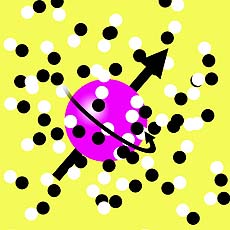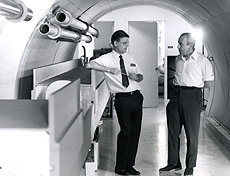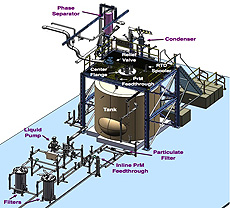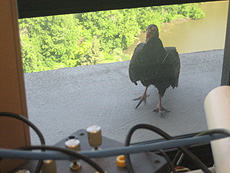|
Have a safe day!
Friday, June 13
3:30 p.m.
DIRECTOR'S COFFEE BREAK - 2nd Flr X-Over
4 p.m.
Joint Experimental-Theoretical Physics Seminar - One West
Speaker: Dmitry Bandurin, University of Virginia
Title: Probing the Nucleon Structure with Multiple Parton Interactions at DZero
Monday, June 16
9 a.m.-5:15 p.m.
FIFE Offline Computing Workshop - CDF Big Room
Free online registration
preferred. May also register for free in person.
2 p.m.
Particle Astrophysics Seminar - Curia II
Speaker: Jason Wright, Pennsylvania State University
Title: A WISE Search for Large Extraterrestrial Civilizations: A Complementary Approach to Traditional SETI
3:30 p.m.
DIRECTOR'S COFFEE BREAK - 2nd Flr X-Over
4 p.m.
All Experimenters' Meeting - Curia II
Special Topic: T-992 and the Si Strip Telescope
Click here for NALCAL,
a weekly calendar with links to additional information.
Ongoing and upcoming conferences at Fermilab |
|
Friday, June 13
- Breakfast: big country breakfast
- Breakfast: chorizo and egg burrito
- Tuscan turkey burger
- Smart cuisine: chana masala
- Barbecue pork empanada
- Honey mustard and Swiss panino
- Chicken fajitas plate
- Tomato basil bisque
- Texas-style chili
- Assorted pizza by the slice
Wilson Hall Cafe menu
|
|
Friday, June 13
Dinner
- Fresh corn and scallop johnnycakes with green onion sauce
- Coffee- and molasses-brined porkchops
- Creamy polenta with parmesan
- Roasted broccoli
- Espresso crepes with ice cream and bittersweet chocolate sauce
Wednesday, June 18
Lunch
- Summer herb chimichurri with grilled steak
- Roasted potatoes
- Sauteed tri-color peppers
- Chocolate caramel cake
Chez Leon menu
Call x3524 to make your reservation.
|
|
Spinning muons
 |
| Subatomic particles like electrons and muons act like tiny magnets. The strength of the magnet is affected by virtual particles. This effect is well known and can be calculated to a precision better than a part in ten billion. A niggling discrepancy between the prediction and measurement of this quantity has the potential to point to physics beyond the Standard Model. Fermilab's Muon g-2 experiment is poised to study this vexing question.
|
If you take an electrical charge and set it in motion, you create a magnet. This is true in both the world of ordinary experience and the quantum world, although the details there are a bit trickier. The simplest quantum system is a single, moving charged particle — say an electron or a muon. While I could select either type of particle for this article, for reasons that will become clear, I concentrate on the muon.
Subatomic particles like the muon have both electrical charge and quantum mechanical spin. Quantum mechanical spin differs a bit from ordinary spin, but it has the same consequence: the spinning muon acts like a magnet. The magnet has a specific strength, determined by the charge of the muon and the fact that it is a spin-1/2 particle. Together, the spin and strength produce an effect that scientists call the magnetic moment.
The prediction of the magnetic moment of the muon (and electron) was first given by Paul Dirac. The measurement involves something called the g factor, and the value of g was predicted to be 2. The way scientists search for deviations from predictions is to measure the quantity (g-2)/2. If the particle had the exact magnetic moment predicted by Dirac, this quantity would be exactly zero. Early measurements of the muon's g factor showed that it differed from predictions by 0.1 percent.
Such a small difference between theory and measurement could be due to measurement or calculation error. However, the predictions and measurements are now very precise. For muons, the measured value of (g-2)/2 is 0.0011659209, where the measurement uncertainty is only in the last "9." That means that all the other numbers are meaningful: The measurement is accurate to one part in ten billion. This is equivalent to measuring the circumference of the Earth at the equator to a precision of just under a quarter inch.
So what causes this 0.1 percent difference? There are many names for it, and two such names are virtual particles and quantum foam. In short, empty space isn't empty space. At the subatomic level, particles are popping in and out of existence like the bubbles in foam. These particles are found in a more concentrated way near particles such as muons. You can think of these virtual particles as bees swarming surrounding a particularly aromatic flower (the muon). These virtual particles alter the strength of the muon's magnetic field.
Scientists can calculate the effect of these virtual particles, and they agree very well with data to high precision. However, the theory and experiment don't agree perfectly. Given the precision of the prediction and the measurement, it is possible that this discrepancy might be the signature of physics beyond the Standard Model. The Fermilab Muon g-2 experiment will study the magnetic moment of muons with greater precision than has been possible in the past. If the discrepancy remains and the uncertainty decreases, it may be that research involving spinning muons might yield the measurement that turns a possible crack in the Standard Model into a broken dam through which a new theory rushes and changes everything.
—Don Lincoln
Want a phrase defined? Have a question? Email today@fnal.gov.
|
June 15, 1967: the lab's beginning
 |
| Laboratory Director Robert R. Wilson and Deputy Director Edwin L. Goldwasser stand in a model of the Main Ring tunnel in the lab's offices at Oak Brook Executive Plaza. Photo: Argonne National Laboratory |
Forty-seven years ago this Sunday (June 15, 1967), the lab's earliest employees and a few employees from the Atomic Energy Commission and DUSAF (the architectural and engineering firm responsible for much of Fermilab's construction) moved into the lab's first offices.
These offices were located on the 10th floor of the newly built Oak Brook Executive Plaza on 1301 W 22nd St., Oak Brook, Illinois. At the time, there was only one tower at Oak Brook Executive Plaza, and there were far fewer buildings near it than there are today, giving these pioneers an unobstructed view of the Illinois farmland. The building was selected for its convenient location between the site chosen for the National Accelerator Laboratory at Weston, Illinois, and O'Hare International Airport. Conditions were Spartan; for its first few weeks of operation, the Oak Brook office lacked furniture and office partitions.
According to the June 16, 1977, issue of the Village Crier commemorating the lab's 10th anniversary, the lab employees present on that Thursday morning were Frank T. Cole, Tom L. Collins, Cy Curtis, Don R. Getz, Edwin L. Goldwasser, J. Luniak, Al Maschke, Don Poillon, A. Linc Read, Robert R. Wilson and Don Young. AEC employees present were Fred Mattmueller, Larry Mohr and Minerva Sanders. DUSAF employees present were William Alexander, M. Warner and E. Parke Rohrer. William Brobeck, a consulting engineer, was also present.
You can read more about the laboratory's early days in the Universities Research Association annual report for 1967.
—from the Fermilab History and Archives Project
|
|
Ultra-pure liquid argon for future neutrino experiments
 |
| Scientists on Fermilab's Liquid-Argon Purity Demonstrator recently showed that liquid argon can achieve a high purity without first having to evacuate the tank of contaminants.
|
Argon, a noble gas, comprises 1 percent of the Earth's atmosphere, making it its third most common gas. When very pure, argon can also aid scientists in detecting neutrinos.
Fermilab's Liquid-Argon Purity Demonstrator, or LAPD, a 30-ton-capacity tank of liquid argon connected to a purifying filter system, contains what scientists call a time projection chamber. Once a neutrino interacts with an argon nucleus, the resulting particles will remove electrons from the surrounding electron atoms. The electrons will then drift toward readout wires strung throughout the chamber. The so-called ionization electrons' arrival at the wires will signal to scientists that a neutrino has just deposited its energy in the argon-filled chamber.
Ultra-pure argon is important for being able to detect the ionization electrons. If the argon contains electronegative impurities — substances that attract electrons, such as water and oxygen — they can derail the electrons before the electrons have a chance to get to the readout wires.
The LAPD tests whether it's possible to achieve a liquid sufficiently free of contaminants without having to evacuate the vessel before filling it with argon, as previous experiments have done. Researchers are building several liquid-argon time projection chamber experiments, including MicroBooNE, with the ultimate goal of building a multikiloton-capacity chamber. In the case of these future, larger vessels, it becomes prohibitively costly to first evacuate them.
The LAPD was designed to achieve the ultra-high purity required by liquid-argon time projection chambers in a vessel that cannot be evacuated. Prior to filling with liquid argon, the ambient atmosphere in the cryostat is removed by purging the tank with argon gas. After the initial purge, the argon gas is subsequently circulated through filters to further reduce these contaminants. Liquid argon is then introduced into the vessel. The liquid is then continuously circulated through the filters to achieve concentrations of water and oxygen on the order of 0.1 parts per billion.
The LAPD's second run period was from December 2012 through September 2013. The cryostat was completely filled with liquid argon, and scientists measured the liquid-argon purity under various operating conditions.
The measurements from purity monitors installed in the cryostat establish for the first time that purities that allow for electron drift lifetimes greater than 6 milliseconds can be achieved in a large volume of liquid argon without first evacuating the vessel. This achieved lifetime largely exceeds the value (1.5 milliseconds) needed by the LBNE for a 2.3-meter-long drift distance.
The LAPD group also measured that the present filter material can remove 0.49 grams of oxygen per kilogram of filter material. This is is a number of great interest to the engineers designing filtration systems for very large liquid argon experiments.
—Tingjun Yang
|
Vulture at the Aerie
 |
| A turkey vulture lands, appropriately enough, on the window by the Aerie conference room, WH15NW. Photo: Bob Peterson, WDRS
|
|
Viewpoint: Top quarks go solo in rare events
From Physics, June 9, 2014
The subatomic elementary particles known as quarks are among the building blocks of the standard model (SM) of particle physics. Protons and neutrons are made of the lightest, up and down quarks, but the unstable strange, charm, bottom, and top quarks can also be produced in high-energy particle accelerators. The enigmatic top quark — which is the heaviest elementary particle, weighing as much as a gold nucleus — has only been studied at Fermilab's Tevatron collider near Chicago and at the Large Hadron Collider at CERN, Geneva.
Read more
|
|